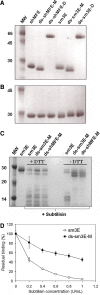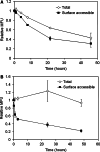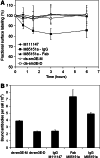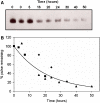Kinetics of anti-carcinoembryonic antigen antibody internalization: effects of affinity, bivalency, and stability
- PMID: 18408925
- PMCID: PMC2840397
- DOI: 10.1007/s00262-008-0518-1
Kinetics of anti-carcinoembryonic antigen antibody internalization: effects of affinity, bivalency, and stability
Abstract
Theoretical analyses suggest that the cellular internalization and catabolism of bound antibodies contribute significantly to poor penetration into tumors. Here we quantitatively assess the internalization of antibodies and antibody fragments against the commonly targeted antigen carcinoembryonic antigen (CEA). Although CEA is often referred to as a non-internalizing or shed antigen, anti-CEA antibodies and antibody fragments are shown to be slowly endocytosed by LS174T cells with a half-time of 10-16 h, a time scale consistent with the metabolic turnover rate of CEA in the absence of antibody. Anti-CEA single chain variable fragments (scFvs) with significant differences in affinity, stability against protease digestion, and valency exhibit similar uptake rates of bound antibody. In contrast, one anti-CEA IgG exhibits unique binding and trafficking properties with twice as many molecules bound per cell at saturation and significantly faster cellular internalization after binding. The internalization rates measured herein can be used in simple computational models to predict the microdistribution of these antibodies in tumor spheroids.
Figures






Similar articles
-
Targeting and therapy of carcinoembryonic antigen-expressing tumors in transgenic mice with an antibody-interleukin 2 fusion protein.Cancer Res. 2000 Aug 15;60(16):4475-84. Cancer Res. 2000. PMID: 10969795
-
Screening and kinetic analysis of recombinant anti-CEA antibody fragments.J Immunol Methods. 1995 Jun 14;183(1):119-25. doi: 10.1016/0022-1759(95)00039-d. J Immunol Methods. 1995. PMID: 7602129
-
Efficient construction of a diabody using a refolding system: anti-carcinoembryonic antigen recombinant antibody fragment.J Biochem. 2002 Dec;132(6):903-9. doi: 10.1093/oxfordjournals.jbchem.a003303. J Biochem. 2002. PMID: 12473192
-
Pharmacokinetics and biodistribution of genetically-engineered antibodies.Q J Nucl Med. 1998 Dec;42(4):225-41. Q J Nucl Med. 1998. PMID: 9973838 Review.
-
Re-targeting of cytotoxic T lymphocytes and/or natural killer cells to CEA-expressing tumor cells with anti-CEA antibody activity.Anticancer Res. 2005 Nov-Dec;25(6A):3725-32. Anticancer Res. 2005. PMID: 16302732 Review.
Cited by
-
Non-genotoxic conditioning for hematopoietic stem cell transplantation using a hematopoietic-cell-specific internalizing immunotoxin.Nat Biotechnol. 2016 Jul;34(7):738-45. doi: 10.1038/nbt.3584. Epub 2016 Jun 6. Nat Biotechnol. 2016. PMID: 27272386 Free PMC article.
-
CT109-SN-38, a Novel Antibody-drug Conjugate with Dual Specificity for CEACAM5 and 6, Elicits Potent Killing of Pancreatic Cancer Cells.Curr Cancer Drug Targets. 2024;24(7):720-732. doi: 10.2174/0115680096260614231115192343. Curr Cancer Drug Targets. 2024. PMID: 38178674
-
Impact of intrinsic affinity on functional binding and biological activity of EGFR antibodies.Mol Cancer Ther. 2012 Jul;11(7):1467-76. doi: 10.1158/1535-7163.MCT-11-1038. Epub 2012 May 7. Mol Cancer Ther. 2012. PMID: 22564724 Free PMC article.
-
High Affinity Promotes Internalization of Engineered Antibodies Targeting FGFR1.Int J Mol Sci. 2018 May 10;19(5):1435. doi: 10.3390/ijms19051435. Int J Mol Sci. 2018. PMID: 29748524 Free PMC article.
-
A mechanistic compartmental model for total antibody uptake in tumors.J Theor Biol. 2012 Dec 7;314:57-68. doi: 10.1016/j.jtbi.2012.08.034. Epub 2012 Sep 6. J Theor Biol. 2012. PMID: 22974563 Free PMC article.
References
-
- Adams GP, et al. High affinity restricts the localization and tumor penetration of single-chain fv antibody molecules. Cancer Res. 2001;61:4750–4755. - PubMed
Publication types
MeSH terms
Substances
Grants and funding
LinkOut - more resources
Full Text Sources
Other Literature Sources

